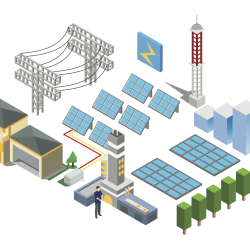Following closure of the San Onofre Nuclear Generating Station (SONGS) in 2013, the Academy’s energy advocacy efforts in various hearings and lawsuits initially focused on preventing the industry’s rush to build massive natural gas “peaker plants” which the Academy helped defeat in both Oxnard and Goleta. During that time, the Academy Research Director Robert Perry learned of Santa Barbara’s extreme energy vulnerability, where the loss of a single pair of transmission lines would debilitate communities within our local distribution system. Under his direction, the Academy broadened its analysis to include system resiliency using local distributed energy resources (DERs), but the concern was tragically realized in 2017-18 with the devastating impact of the Thomas Fire and Montecito Debris Flows.
The increasing prevalence of wildfires (often sparked by utility wires) and other extreme weather events highlights the urgent need for DERs and local microgrid systems to provide true resiliency against climate-induced disruption and state authorized Public Safety Power Shutoffs (PSPS) that would preemptively deenergize transmission lines. Unfortunately, there are many hurdles to be cleared before microgrids and distributed energy resources (DERs) are widely adopted in California. A powerful lobbying effort supporting expensive regional transmission grids is also ongoing, and state policy must be enacted to provide a level playing field for both locally distributed and regionally transmitted energy.
Today, there are dozens of regulatory proceedings and legislative proposals addressing a wide range of issues related to community choice in developing local DERs that will help withstand the onslaught of climate change. Strategies to address these issues lie within the traditional scope of city and county planning, but a statewide collaborative structure is desperately needed to strengthen and coordinate local government and energy system planning. Enter Advanced Community Energy (ACE), a statewide collaborative program conceived by visionary Lorenzo Kristov, an energy economist, policy analyst and consultant who has collaborated with the Academy in the past regarding the future of the energy grid and how to create resilient communities.
Today, Robert is working with a core group of energy policy analysts and organizations as part of a “ground floor” effort to develop and transition the ACE concept into law. The primary objective of ACE will be to integrate state energy policy and programs into a collaborative framework (see below) that enrolls local governments in planning for the rapid development of local DERs and microgrids at critical facilities. In developing this program, Perry will represent the Academy in presenting the Goleta Load Pocket as a primary case study on how ACE legislation can create energy resilience and reliability within areas vulnerable to climate change impacts. The ACE working group is currently developing materials for presentation to state and local stakeholders, with a view towards submitting proposed legislation for adoption in 2020.

